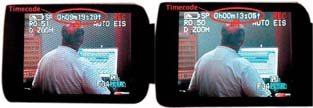Hack 4. Black and Code a Tape
| < Day Day Up > |
|
You can avoid problems with digitizing your footage by prerecoding timecode on your tapes before you record footage on them . Digital video provides you with a professional level of accuracy while editing through the use of timecode. A movie is simply a series of still images, or frames, displayed quickly and in succession. Timecode is a method of referring to, and tracking, each of those frames. The frame rate of the video is the measurement of how many frames are displayed per second.
Timecode is used as a reference point for editing. If you have the same timecode occur on a tape more than once, you will have an exceptionally difficult task determining which image to use. Therefore, you want each frame of your video to be associated with a unique timecode. 1.5.1. Viewing TimecodeMany cameras generate timecode, starting at 00:00:00;00, whenever they are turned off and turned on again. This can become a problem during production, because you might be attempting to conserve battery power while recording and consequently turning the camera off and on frequently. Because of this, you could wind up with a tape with numerous duplicate timecodes. An easy way to tell if you have regenerated timecode is to simply look at the current timecode of the tape in your camera's viewfinder. For example, if you have recorded 10 minutes of footage, turned off and on your camera, and then notice the timecode is at or near 00:00:00;00, then you have more than likely regenerated timecode. Figure 1-4 shows the timecode displayed on an LCD both before (left) and after (right) cycling the camera off and on.
Figure 1-4. Keeping an eye out for timecode that "jumps" backward In order to avoid a duplicate timecode fiasco, you can perform a simple task: black and code your tapes. Black and code refers to the process of recording a black image across your entire tape while allowing the camera, or deck, to assign a continuous timecode for every frame of video. After performing this task, you will be able to turn off your camera safely, because it will not overwrite timecode that is already present. However, it will record over the black image. 1.5.2. Determining the Frame RateThe vast majority of time, you will be dealing with video that has a frame rate of 29.97 frames per second (fps) for National Television Systems Committee (NTSC) video or 25 fps for Phase Alternation by Line (PAL) video. There is a reason for the noninteger frame rate for NTSC, but I'll leave that for you to research. (Hint: television was not always broadcast in color.) Here are the timecodes for the major digital video standards:
1.5.3. Creating a Black and Coded TapeTo black and code your tapes, you have a few options. Whichever option you choose, you should make sure you black and code your tapes before recording actual footage on them. Yes, people have actually attempted to do so after they have recorded footage…quite unsuccessfully. 1.5.3.1. Using your editing system.If your editing system provides a Black and Code option, you should use it. Apple's Final Cut Pro, Avid Xpress, and Adobe Premiere are a few of the mainstream editing systems that provide this functionality. If your editing system does not offer a Black and Code option, you can create a new timeline with a long black slug. Your slug should be as long as your tape, so if you are planning on recording to a 60-minute tape, your slug should be 60 minutes long as well. After you have created the timeline, simply record it to tape. An advantage of this method, depending on the capabilities of your editing system, is that you can set the starting point of your timecode. For example, you can start the timecode of your first tape at hour one (01:00:00;00), your second tape at hour two (02:00:00;00), and so on. If your editing system does not transfer the timecode you assign, you can still use it to send a black image while your deck or camera assigns timecode. But in such cases, you may just want to use your camera by itself, as it has a built in method of creating black. 1.5.3.2. Using your camera.You can create black with your camera by leaving the lens cap on and recording. Because the lens is covered, your camera will record a black image (because there's no image to record), while assigning continuous timecode to the tape. This will give you a functional black and coded tape.
1.5.3.3. Using your tape deck.You can save the wear on your camera's heads by black and coding your tapes using a digital video deck. If you are planning on acquiring a lot of footage, you should invest in a deck. When using a deck to black and code a tape, you can either use your editing system's built-in function (as discussed previously in "Using your editing system") or send a black signal to the tape deck's analog video input. 1.5.3.4. Purchasing precoded tapes.Many professional post-production facilities also offer precoded tapes. There is usually an additional charge, beyond the cost of the raw tape stock. Although most facilities use these tapes for their clients' editing sessions, you should be able to purchase them for use outside of their facility, as well. |
| < Day Day Up > |
EAN: 2147483647
Pages: 158

